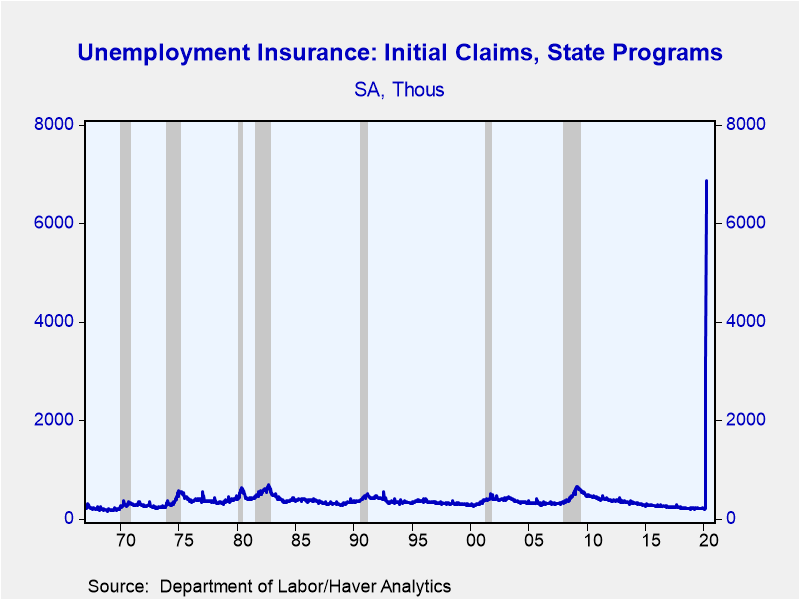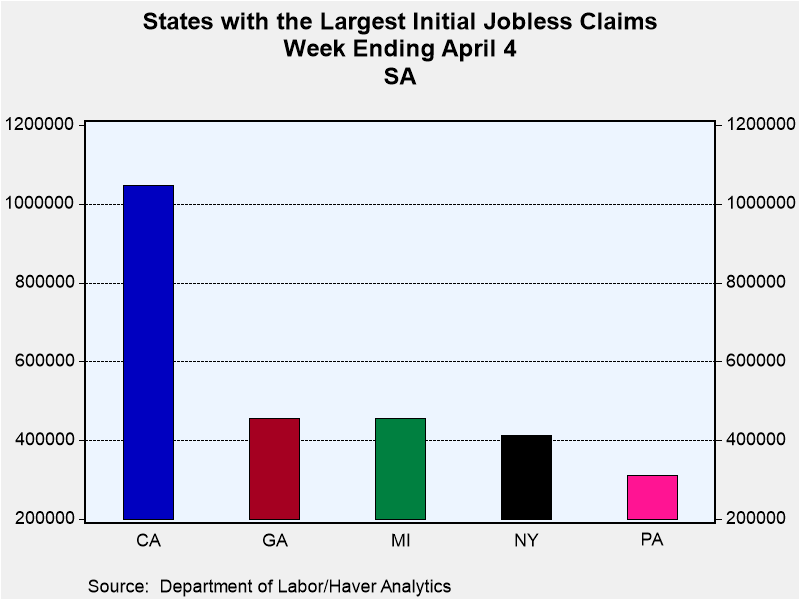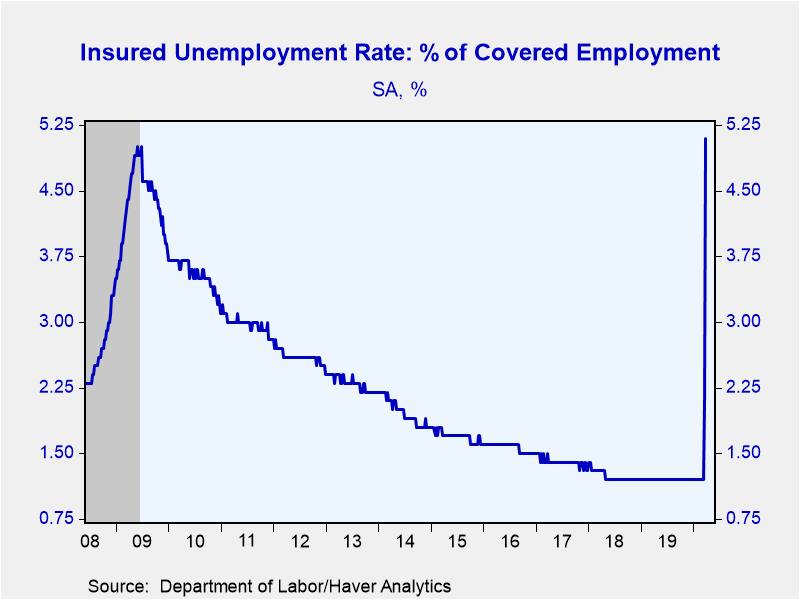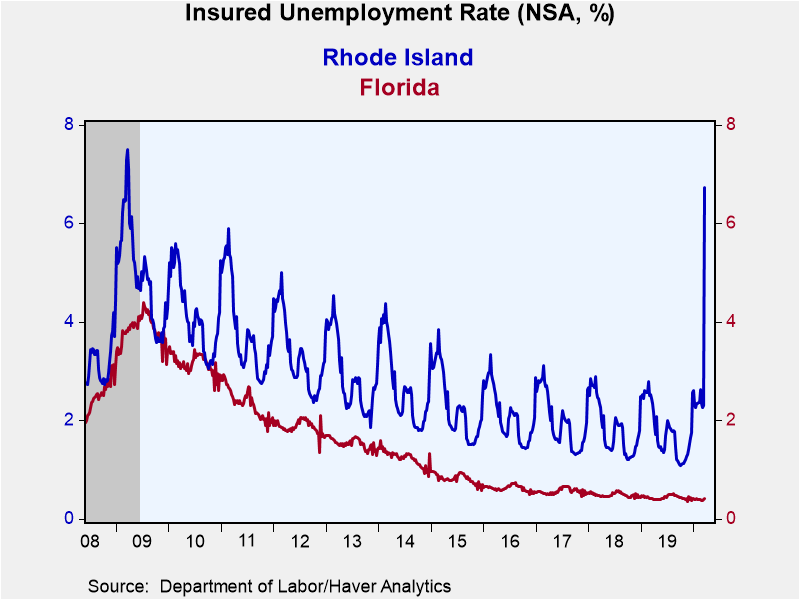 Global| Apr 09 2020
Global| Apr 09 2020Over 10% of the U.S. Labor Force has Filed Initial Claims in the Last Three Weeks
Summary
• Initial jobless claims declined slightly to 6.606 million in the week ending April 4. • Over the last three weeks 16.8 million people have filed new claims. • This suggests an over 10 percentage point rise in the unemployment rate. [...]
• Initial jobless claims declined slightly to 6.606 million in the week ending April 4.
• Over the last three weeks 16.8 million people have filed new claims.
• This suggests an over 10 percentage point rise in the unemployment rate.
• Twenty-two states had over 100,000 new claims.
Initial jobless claims for unemployment insurance declined 261,000 to 6.606 million (3,154% year-on-year) during the week ending April 4. The previous week was revised up to a record 6.867 million from 6.648 million. The previous high for claims was 695,000 set in 1982. During the last three weeks 16.8 million or 10.3% of the labor force have filed new claims. The Action Economics Forecast Survey anticipated 5.0 million new claims.
The four-week moving average of initial claims, which smooths out week-to-week volatility and is less important at the moment since it does not capture the full extent of coronavirus shutdowns, jumped to 4.266 million from 2.667 million.
Twenty-two states had over 100,000 in claims in the week ending April 4. Claims topped 1 million in California for the second consecutive week (1.049 and 1.106 million), followed by Georgia (456,784), Michigan (455,598), and New York (413,221). Claims increased the most in Georgia (286,399 or 168%) followed by New York (29,392) and Michigan (28,101). Meanwhile, Pennsylvania, Florida and Michigan saw notable declines (-142,777; -107,729, and -102,989 respectively). The state numbers are based on seasonally-adjusted data calculated by Haver Analytics. The Department of Labor notes that advance claims are not directly comparable to claims reported in prior weeks and Pennsylvania indicated these numbers are only estimates. A more accurate picture of state claims in the week ending April 4 will be available next week.
Continuing claims for unemployment insurance increased 4.396 million to a record 7.455 million (337% y/y) in the week ending March 28, from an upwardly revised 3.059 million (was 3.029). The four-week moving average of claimants increased to 3.5 million from 2.061 million. The insured rate of unemployment jumped to a 38-year high of 5.1%. The state insured rates of unemployment are lagged by two weeks and thus illustrate the impact of differences in the timing of stay-at-home orders. Rates in Florida remained low (0.41%) while Rhode Island jumped 6.73% (this data is not seasonally adjusted).
Data on weekly unemployment claims going back to 1967 are contained in Haver's WEEKLY database, and they are summarized monthly in USECON. Data for individual states are in REGIONW. The expectations figure is from the Action Economics Forecast Survey, carried in the AS1REPNA database.
| Unemployment Insurance (SA, 000s) | 04/04/20 | 03/28/20 | 03/21/20 | Y/Y % | 2019 | 2018 | 2017 |
|---|---|---|---|---|---|---|---|
| Initial Claims | 6,606 | 6,867 | 3,307 | 3,154.2 | 218 | 221 | 244 |
| 4-wk avg | 4,265.50 | 2,666.75 | 1,004.25 | -- | -- | -- | -- |
| Continuing Claims | -- | 7,455 | 3,059 | 337.2 | 1,701 | 1,756 | 1,961 |
| 4-wk avg | -- | 3,500.00 | 2,061.00 | -- | -- | -- | -- |
| Insured Unemployment Rate (%) | -- | 5.1 | 2.1 |
1.2 |
1.2 | 1.2 | 1.4 |
Gerald D. Cohen
AuthorMore in Author Profile »Gerald Cohen provides strategic vision and leadership of the translational economic research and policy initiatives at the Kenan Institute of Private Enterprise.
He has worked in both the public and private sectors focusing on the intersection between financial markets and economic fundamentals. He was a Senior Economist at Haver Analytics from January 2019 to February 2021. During the Obama Administration Gerald was Deputy Assistant Secretary for Macroeconomic Analysis at the U.S. Department of Treasury where he helped formulate and evaluate the impact of policy proposals on the U.S. economy. Prior to Treasury, he co-managed a global macro fund at Ziff Brothers Investments.
Gerald holds a bachelor’s of science from the Massachusetts Institute of Technology and a Ph.D. in Economics from Harvard University and is a contributing author to 30-Second Money as well as a co-author of Political Cycles and the Macroeconomy.









